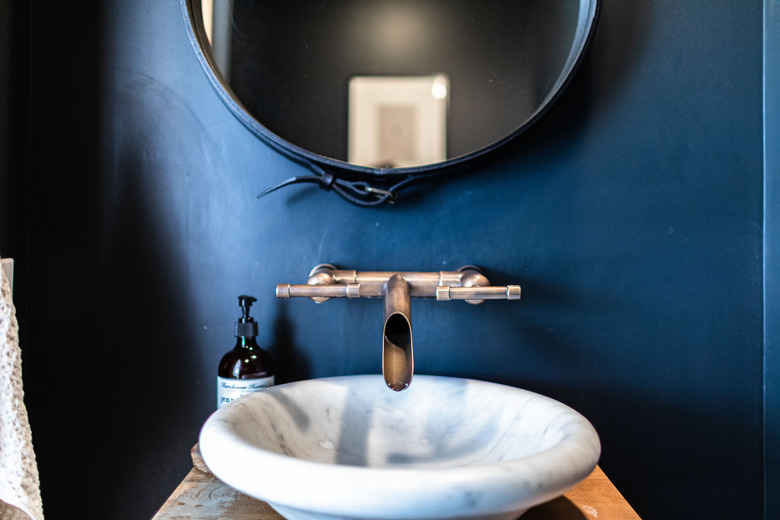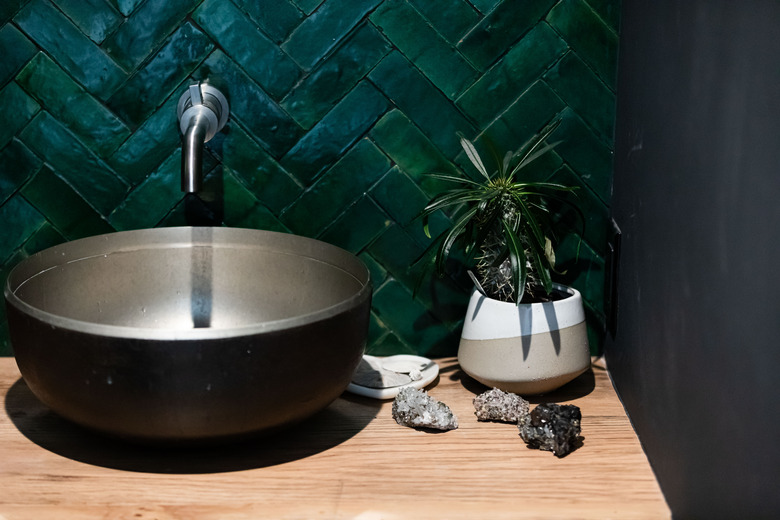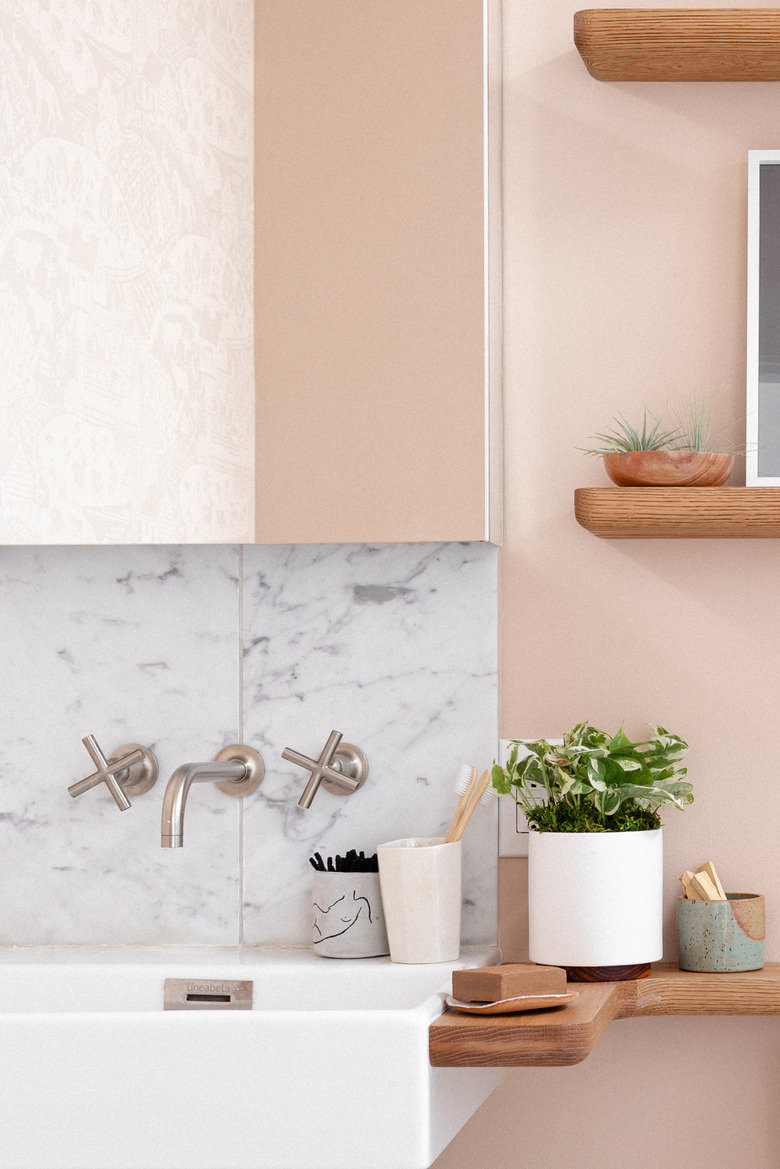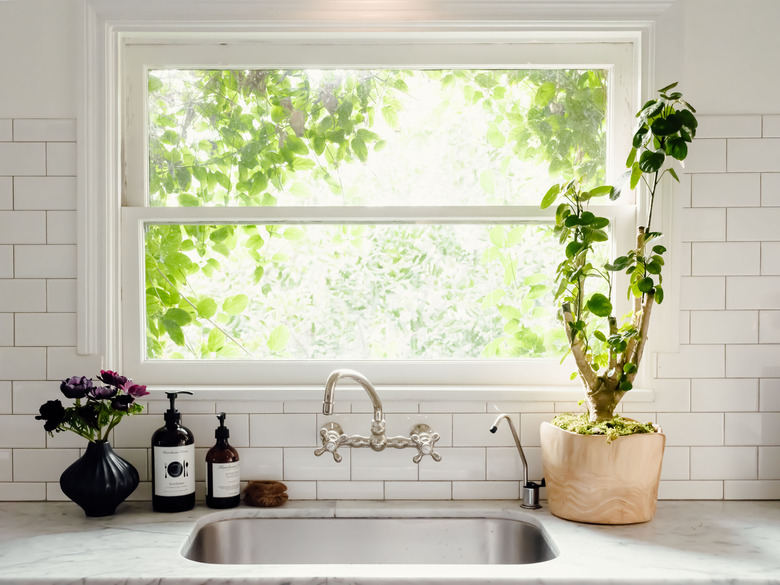Wall-Mount Faucets: What You Need To Know
We may receive a commission on purchases made from links.
A wall-mount faucet is one that mounts directly to the wall, as opposed to the deck-mount alternative that you install on the sink or tub deck or the countertop. A real space-saver, the wall-mount faucet is often characterized as innovative by kitchen designers and faucet manufacturers, but wall-mounts have probably been around just as long, if not longer than, deck-mounts. Consider that some of the original household faucets, which weren't much different from garden spigots, were mounted on the wall.
What's actually innovative is the way the wall-mount design makes industrial utilitarianism accessible for the modern kitchen or bathroom. Because they provide longer spout reach and more space under the spout than deck-mounts, many of the faucets in commercial kitchen sinks are wall-mounts, and residential wall-mount faucets preserve these benefits while offering contemporary designs that complement today's most popular countertop and backsplash materials, like stone, quartz, wood and metal.
If you're considering a wall-mounted faucet for your kitchen or bathroom, you'll find plenty of models from which to choose. Although single-handle models are available, most wall mounts have two handles, mostly for their decorative value. One important factor to take into consideration is that installing a wall-mount is more difficult than installing a deck-mount and involves installing new rough-in plumbing behind the wall.
Planning for a Wall-Mount Faucet
Planning for a Wall-Mount Faucet
Almost by default, kitchens and bathrooms are plumbed for deck-mount faucets that install onto standard drop-in sinks or onto the countertop for undermount sinks. Hot and cold supply lines typically stub out through the floor or through the wall underneath the sink, and a drop-in sink usually has predrilled faucet holes so you can drop in a deck-mount faucet and connect it to the supply shutoff valves with removable hoses.
For a wall-mount faucet, the plumbing is a little different. The water lines must stub out above the sink, and since the sink should have no predrilled faucet holes, an undermount sink or vessel sink works better than a standard drop-in sink. The height of the stub-outs determines the amount of working room there is in the sink, and since that depends on the faucet style and the sink model and height, you need to set all these parameters before you do the rough-in plumbing for the faucet.
What's Involved With Installation?
What's Involved With Installation?
Because the supply lines for a wall-mount faucet are behind the walls, you have to remove the wall covering so you can install them, and depending on the faucet model, you'll probably have to install extra blocking to support the faucet valves or valve body. Some models have valves hidden behind the wall that, like shower valves, need to be connected to the supply pipes before you cover the wall. Others have compression fittings that attach directly to the exposed pipes sticking out of the wall and to which the faucet trim is attached.
You'll probably have to install new shutoff valves, and placement of these valves is a specific design issue. They usually can't go directly under the faucet as they do for a deck-mount, but you can install them anywhere along the faucet-supply pipes. Some plumbers opt to put them behind a panel in an adjoining room or in a crawl space or basement below the bathroom. The valves can also be installed inside of an enclosed vanity cabinet.
Why Choose a Wall-Mount Faucet?
Why Choose a Wall-Mount Faucet?
The extra work involved with installation, which usually has to be completed by a plumber, is a drawback, but a wall-mount faucet offers plenty of benefits to offset it:
- It's a space-saver: A faucet that you install on the sink deck or countertop pushes the sink forward a minimum of 4 inches, and that might not sound like a lot, but it's prime real estate in a small bathroom. A wall-mount bathroom faucet allows for the installation of a wall-mount lavatory or similar compact sink, and in the kitchen, the ability to push the sink back toward the wall frees up food-prep space on the front of the countertop and creates more storage space in the sink cabinet.
- It's a design feature: Wall-mount faucet designs can be every bit as stylish as deck-mount ones, with materials such as solid brass or stainless steel with a polished, burnished or matte black finish and featuring a squared-off or contoured spout and handles. You can install a widespread model with handles that connect to the spout behind the walls to make them appear disconnected or a bridge-style kitchen faucet to complement an antique design scheme.
- It's utilitarian: The extended reach of the spout makes a wall-mount faucet as much a favorite in busy household kitchens as in commercial ones, where heavy-duty wall-mount faucets are the norm. Because you can mount the faucet high above the sink, you have extra space underneath it to pile dishes and wash big pots.
- It may be the only option: If your busy kitchen needs a pot filler to allow you to fill large pots while they're sitting on the stove or countertop, a wall-mount design is your only option. A pot filler has a swivel spout that doubles the reach of a standard faucet, and it may have a handle on the faucet body and an additional handle on the spout so you can control the water without reaching. The only wall-mount faucets offered by Moen, a leading manufacturer, are pot fillers.
Wall-Mount Faucet Design
Wall-Mount Faucet Design
The conventional single-handle mixing valve design for a deck-mount kitchen or bathroom faucet, with the handle attached directly to the spout, doesn't work for a wall mount. Many manufacturers, such as Kohler, offer a line of stylish models featuring a single handle mounted in the wall like the handle for a shower valve. You can even find hands-free wall-mount faucets, such as those in the Kohler Purist line, with motion-sensor technology that calibrates activity in the vicinity to gauge whether or not to turn on the water and how much water flow to provide.
Compression valves were common in older wall-mounts, which usually had cross handles that you rotated multiple times to turn the water on and off. Modern faucet manufacturers are trending away from compression valves, so contemporary wall-mount faucets have cartridge or disk valves that you can only turn through 90 degrees. Many of these faucets still feature the familiar cross handles for a vintage look, but levers are just as common, and because they are easier to operate, levers are preferable if you're designing the bathroom or kitchen to be ADA-compliant.
You won't find many wall-mount faucets with pull-down or pull-out spouts, although they do exist. The sprayer has to be connected to the water supply by hidden hoses that can potentially leak, and it's a bad idea to put these hoses behind a finished wall. That doesn't mean you can't have a side sprayer, though, because the sprayer can be attached to the faucet body by an external hose. The hose and sprayer can be finished in the same material as the faucet to create an integrated look, as is evident with the Rohl Aqui wall-mount kitchen faucet.
Keeping Your Wall-Mount Faucet Clean
Keeping Your Wall-Mount Faucet Clean
Even though it isn't mounted as close to the sink opening as a deck mount, a wall-mount faucet can still suffer all the indignities caused by corrosion and water staining. You use the same techniques to handle these problems as you would use for any deck mount, and in some cases, you'll find the job easier. Widespread wall-mount faucets and single-handle ones tend to have removable trim, which makes cleaning easier.
Cleaning methods vary according to finish, but most metals benefit from an occasional buffing with metal polish. Stainless steel requires special care because chlorine and chlorides cause permanent staining, known as pitting. Stainless steel should never come in contact with chlorine bleach or table salt (sodium chloride), so when cleaning the faucet, do not use any product that contains bleach as a disinfectant, and when filling pots with salty water, don't allow any water to splash onto the faucet. If it does, wipe it off immediately.
Hard-water staining, which can mar the finish as the faucet ages, comes off with ordinary household vinegar, but it has to be in prolonged contact to remove tough stains. A good way to accomplish this is to mix the vinegar with borax powder to make a paste. Apply the paste liberally and let it sit for several hours before rinsing with clean water.
Wall-Mount Faucet Repair
Wall-Mount Faucet Repair
When a wall-mount faucet leaks from the spout, the problem is usually a worn valve, and you need to disassemble the faucet to access it. It's important to turn off the water before you do this, and if you didn't install the faucet yourself, you may have to search a bit to find the shutoff valves. Plumbers tend to place them behind a panel in the same room as the faucet, but they could also be in an adjacent room or in the basement or crawl space.
Once you have turned off the water, the typical repair procedure for a double-handle wall mount involves these basic steps:
- Unscrew and remove one or both of the handles, depending on whether the faucet is dripping hot or cold water. You'll probably have to pry off a plastic cap to access the screw.
- Unscrew the valve retaining nut using locking pliers or a wrench.
- Pull out the valve and inspect it. If it's coated with scale, soak it overnight in vinegar to dissolve the scale. If it's cracked or damaged, replace it.
- Remove all the rubber gaskets and O-rings and replace them. These usually come in a model-specific repair pack that you can find at the hardware store.
- Put everything back together, turn on the water and test for leaks before you celebrate a job well done.
One of the disadvantages of a wall-mount faucet is that leaks can occur at the points of connection on the wall or even behind the wall. When this happens, it's usually because of corrosion, and the repair could involve replacing some of the rough-in piping, which means cutting into the wall. It's for situations like this that every homeowner needs to have the number of a friendly and responsive plumber.



